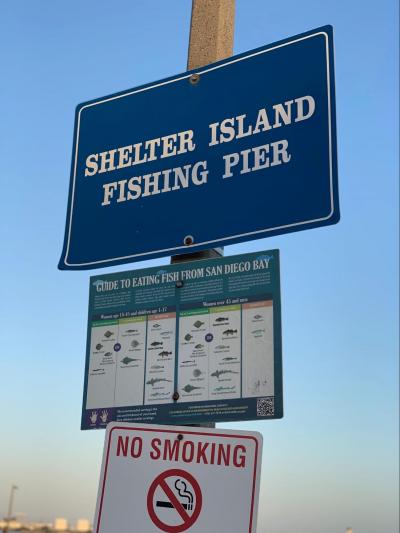Like many coastal cities, San Diego Bay’s five public piers are dotted with locals dropping lines in the hopes of a freshly caught seafood supper. Here, residents try their luck near publicly posted signs by the California Office of Environmental Hazard Assessment reminding them of the potential risks of eating more than the recommended amounts of certain types of nearshore fish.
San Diego Bay, like many urban waterways across the nation, has measurable levels of pollutants and contaminants including “forever chemicals” like PCBs and PFAS, insecticides like pyrethroids, phosphate flame retardants and others that may pose risks to people who regularly consume certain types of seafood. While contaminant levels in popular local finfish like spotted turbot, spotted sand bass, black perch and yellowfin croaker have been assessed for safety, information on bay-caught lobster, crab or other shellfish like oysters, has begun but is less complete.
In a new paper published in the journal Environments, California Sea Grant Extension Specialist Theresa Talley and her colleagues take a closer look at locally caught California spiny lobster and two species of crab. Combining these findings with spiny lobster tail contamination data from an earlier study, researchers found a total of 22 contaminants in spiny lobster; with five exceeding consumption thresholds and eight contaminants still without guidelines. While only two crabs were tested for this study, five of the ten contaminants tested were found, with one exceeding consumption thresholds.
It’s safe to say that most local recreational fishers aren’t harvesting bushels of wild crab from beneath the piers, but they frequently target spiny lobster during the region’s recreational harvesting season which runs from October to mid-March. Current consumption guidelines which are based on concentrations of mercury and PCBs suggest that women between the ages of 18-49 and children under the age of 17 limit their meals to one serving of spiny lobster tail per week if harvested in the bay. For men over the age of 18, and women over the age of 50, the recommendation is no more than two servings per week. However, there is no distinction in the guidelines for whether tails (muscle) or viscera are eaten even though the types and levels of contaminants can vary widely between these parts.
The new research likely won’t immediately change consumption advice, but adds emerging contaminant data and seafood preparation considerations to the broader conversation of safety recommendations.

“For the most part, spiny lobsters are safe but there are emerging chemicals, like benzyl butyl phthalate (a compound used in plastics), PBDEs (a class of flame retardants), small plastics and other debris, and others that are worth further monitoring and prioritizing for the development of consumption guidelines,” says Talley.
Where crabs and lobsters are harvested is only part of the story. Which specific parts of the shellfish are eaten and how it’s prepared can also impact contaminant consumption risk.
Talley’s study also revealed that people’s preferences for eating tails and viscera, including dishes like broth made from whole lobster, did not differ across ethnic, cultural and socioeconomic backgrounds, and recommends that consumption warnings be shared broadly and in culturally sensitive ways to ensure that they effectively reach everyone.
“Knowing what contaminants are in the shellfish can inform future assessments of how to reduce risk, including prioritizing contaminants to be included in consumption guidelines and preparation methods—for example, whether cooking can help break down certain contaminants and make them less harmful,” says Talley. Simply detecting the presence of a chemical isn’t enough, however, to determine whether a locally caught fish is safe to eat.
“That will require collaboration among scientists, public health experts, resource managers, key community members and others to develop effective solutions and reach people across the region.”
About California Sea Grant
NOAA’s California Sea Grant College Program funds marine research, education and outreach throughout California. Headquartered at Scripps Institution of Oceanography at the University of California San Diego, California Sea Grant is one of 34 Sea Grant programs in the National Oceanic and Atmospheric Administration (NOAA), U.S. Department of Commerce.